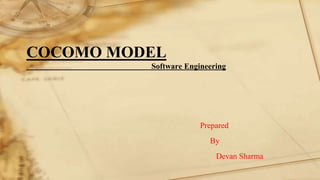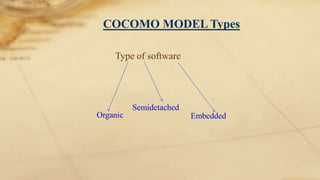Cocomo model
- 2. COCOMO Model COCOMO was first published in 1981 Barry W. Boehm's Book Software engineering economics Fig : 1 W.Boehm
- 3. COCOMO Model COCOMO model is used to estimate size ,cost and time of software to be developed Cost Size Time Fig 2: Need of COCOMO
- 4. COCOMO MODEL Types Type of software Semidetached Organic Embedded
- 5. COCOMO Mode Project size Nature of Project Organic Typically 2-50 KLOC Small size project, experienced developers in the familiar environment. For example, pay roll, inventory projects ,Banking system Semi detached Typically 50-300 KLOC Medium size project, Medium size team, Average previous experience on similar project. For example: Utility systems like compilers, database systems Embedded Typically over 300 KLOC Large project, Real time systems, Complex interfaces, Very little previous experience. For example: ATMs, Air Traffic Control ,Navigation satellite Table 1: The comparison of three COCOMO modes
- 6. Person-Month ? Person-month (PM) is considered to be an appropriate unit for measuring effort
- 7. COCOMO MODEL The Constructive Cost Model (COCOMO) Constructive Cost model (COCOMO) Basic Intermediate Complete(detailed) Model proposed by B. W. BoehmĄŊs through his book Software Engineering Economics in 1981
- 8. COCOMO MODEL Basic Model Basic COCOMO model takes the form E=ab(KLOC) PM bb db D=cb (E) where E is effort applied in Person-Months, and D is the development time in months. The coefficients ab, bb, cb and db are given in table Months
- 9. Fig 3: COCOMO Model equation
- 10. Effort versus product size. Fig 4 : Graph for effort
- 11. Development time versus size. Fig 4 : Graph for Time
- 12. Disadvantages of Basic COCOMO Model ? It considers only KLOC to estimate effort ? It can not be used for modern tools ? It does not consider different parameters Note : Intermediate COCOMO model considers different parameters to estimate effort and time
- 13. COCOMO MODEL Intermediate Model Cost drivers (i) Product Attributes Required s/w reliability (accuracy) Size of application database Complexity of the product (ii) Hardware Attributes Run time performance constraints Memory constraints Speed of system
- 14. COCOMO MODEL (iii) Personal Attributes Analyst capability Programmer capability Application experience Virtual m/c experience Programming language experience (iv) Project Attributes Modern programming practices Use of software tools
- 15. COCOMO model Disadvantage of basic and intermediate COCOMO model ? A major shortcoming of both the basic and the intermediate COCOMO models is that they consider a software product as a single homogeneous entity. ? Now these days large software systems are made up of several smaller sub-systems or modules with different characteristics.
- 16. Complete COCOMO model ? The complete COCOMO model considers different subsystems of the software ? For example CU website has different modules or subsystem ? Graphical user interface (Front End) ? Database (your data is stored )
- 17. Complete COCOMO model ? Different modules or subsystems of the complete COCOMO model ?Database part ? Graphical user interface (GUI) part ? Communication part ? Communication part can be considered as embedded software. ? The database part could be semi-detached software ? The GUI part organic software. The costs for these three components can be estimated separately, and summed up to give the overall cost of the system

















